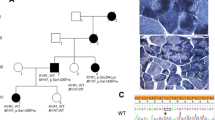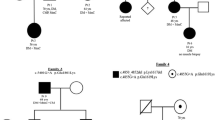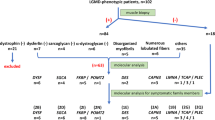Abstract
Background
Bethlem myopathy represents the milder phenotype of collagen type VI-related myopathies. However, clinical manifestations are highly variable among patients and no phenotype-genotype correlation has been described. We aim to analyse the clinical, pathological and genetic features of a series of patients with Bethlem myopathy, and we describe seven new mutations.
Methods
A series of 16 patients with the diagnosis of Bethlem myopathy were analyzed retrospectively from their medical records for clinical, creatine kinase (CK), muscle biopsy, and muscle magnetic resonance (MRI) data. Genetic testing was performed through next-generation sequencing of custom amplicon-based targeted genes panel of myopathies. Mutations were confirmed by Sanger sequencing.
Results
The most frequent phenotype consisted of proximal limb weakness associated with interphalangeal and wrists contractures. However, cases with isolated contractures or isolated myopathy were found. CK levels did not correlate with severity of the disease. The most frequent mutation was the COL6A3 variant c.7447A>G, p.Lys2486Glu, with either an homozygous or compound heterozygous presentation. Five new mutations were found in COL6A1 gene and other two in COL6A3 gene, all of them with a dominant heritability pattern. From these, a new COL6A1 mutation (c.1657G>A, p.Glu553Arg) was related to an oligosymptomatic phenotype with predominating contractures in the absence of weakness and a normal muscle MRI. Finally, the most common COL6A1 mutation reported to date that leads to an Ullrich phenotype (c. 868G>A, p.Gly290Arg), has been found here as Bethlem presentation.
Conclusions
Manifestations of Bethlem myopathy are quite variable, so either contractures or weakness may be lacking, and no phenotype-genotype associations can be brought.

Similar content being viewed by others
References
Briñas L, Richard P, Quijano-Roy S, Gartioux C, Ledeuil C, Lacène E et al (2010) Early onset collagen VI myopathies: genetic and clinical correlations. Ann Neurol 68(4):511–520
Merlini L, Martoni E, Grumati P, Sabatelli P, Squarzoni S, Urciuolo A et al (2008) Autosomal recessive myosclerosis myopathy is a collagen VI disorder. Neurology 71(16):1245–1253
Scacheri PC, Gillanders EM, Subramony SH, Vedanarayanan V, Crowe CA, Thakore N et al (2002) Novel mutations in collagen VI genes: expansion of the Bethlem myopathy phenotype. Neurology 58(4):593–602
Okada M, Kawahara G, Noguchi S, Sugie K, Murayama K, Nonaka I et al (2007) Primary collagen VI deficiency is the second most common congenital muscular dystrophy in Japan. Neurology 69(10):1035–1042
Kim SY, Kim WJ, Kim H, Choi SA, Lee JS, Cho A et al (2018) Collagen VI-related myopathy: expanding the clinical and genetic spectrum. Muscle Nerve 58(3):381–388
Foley AR, Hu Y, Zou Y, Columbus A, Shoffner J, Dunn DM et al (2009) Autosomal recessive inheritance of classic Bethlem myopathy. Neuromuscul Disord 19(12):813–817
Gualandi F, Urciuolo A, Martoni E, Sabatelli P, Squarzoni S, Bovolenta M et al (2009) Autosomal recessive Bethlem myopathy. Neurology 73(22):1883–1891
González-Pérez A, López-Bigas N (2011) Improving the assessment of the outcome of nonsynonymous SNVs with a consensus deleteriousness score, Condel. Am J Hum Genet 88(4):440–449
Desmet F-O, Hamroun D, Lalande M, Collod-Béroud G, Claustres M, Béroud C (2009) Human splicing finder: an online bioinformatics tool to predict splicing signals. Nucleic Acids Res 37(9):e67–e67
Mercuri E, Lampe A, Allsop J, Knight R, Pane M, Kinali M et al (2005) Muscle MRI in Ullrich congenital muscular dystrophy and Bethlem myopathy. Neuromuscul Disord 15(4):303–310
Fu J, Zheng Y-M, Jin S-Q, Yi J-F, Liu X-J, Lyn H et al (2016) “Target” and “Sandwich” signs in thigh muscles have high diagnostic values for collagen VI-related myopathies. Chin Med J 129(15):1811
Lampe AK, Dunn DM, von Niederhausern AC, Hamil C, Aoyagi A, Laval SH et al (2005) Automated genomic sequence analysis of the three collagen VI genes: applications to Ullrich congenital muscular dystrophy and Bethlem myopathy. J Med Genet 42(2):108–120
Hunter JM, Ahearn ME, Balak CD, Liang WS, Kurdoglu A, Corneveaux JJ et al (2015) Novel pathogenic variants and genes for myopathies identified by whole exome sequencing. Mol Genet Genom Med 3(4):283–301
Martins AI, Maarque C, Pinto-Basto K, Negrão L (2017) Bethlem myopathy in a Portuguese patient—case report. Acta Myol 36(3):178–181
Fan Y, Liu A, Wei C, Yang H, Chang X, Wang S et al (2018) Genetic and clinical findings in a Chinese cohort of patients with collagen VI-related myopathies. Clin Genet 93(6):1159–1171
Suárez B, Lozano-Arango A, Araneda D, Cortés F, Hervias C, Calcagno G et al (2018) Collagen VI related myopathies. When to suspect, how to identify. The contribution of muscle magnetic resonance. Rev Chil Pediatr 89(3):399–408
Butterfield RJ, Foley AR, Dastgir J, Asman S, Dunn DM, Zou Y et al (2013) Position of glycine substitutions in the triple helix of COL6A1, COL6A2, and COL6A3 is correlated with severity and mode of inheritance in collagen VI myopathies. Hum Mutat 34(11):1558–1567
Pace RA, Peat RA, Baker NL, Zamurs L, Mörgelin M, Irving M et al (2008) Collagen VI glycine mutations: perturbed assembly and a spectrum of clinical severity: collagen VI glycine mutations. Ann Neurol 64(3):294–303
Reddy HM, Cho K-A, Lek M, Estrella E, Valkanas E, Jones MD et al (2017) The sensitivity of exome sequencing in identifying pathogenic mutations for LGMD in the United States. J Hum Genet 62(2):243–252
Giusti B, Lucarini L, Pietroni V, Lucioli S, Bandinelli B, Sabatelli P et al (2005) Dominant and recessive COL6A1 mutations in Ullrich scleroatonic muscular dystrophy. Ann Neurol 58(3):400–410
Deconinck N, Richard P, Allamand V, Behin A, Laforet P, Ferreiro A et al (2015) Bethlem myopathy: long-term follow-up identifies COL6 mutations predicting severe clinical evolution. J Neurol Neurosurg Psychiatry 86(12):1337–1346
Funding
There is no funding.
Author information
Authors and Affiliations
Corresponding author
Ethics declarations
Conflicts of interest
The authors declare that they have no competing interests.
Rights and permissions
About this article
Cite this article
Panadés-de Oliveira, L., Rodríguez-López, C., Cantero Montenegro, D. et al. Bethlem myopathy: a series of 16 patients and description of seven new associated mutations. J Neurol 266, 934–941 (2019). https://doi.org/10.1007/s00415-019-09217-z
Received:
Revised:
Accepted:
Published:
Issue Date:
DOI: https://doi.org/10.1007/s00415-019-09217-z




